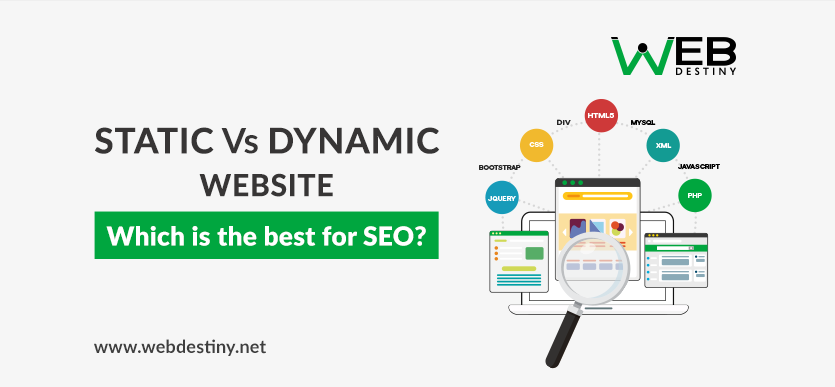Static Vs Dynamic Website : Which is the best for SEO?

Static Vs Dynamic Websites
As we progress in this technology era, we are bound to let go of many things that we embraced in the past to make way for advanced technologies to take their place. As content management systems rose into popularity, static websites were the ones which received the hit. Since then, a Static Vs Dynamic website debate has been heating up. But has the time reached to let them go? Are dynamic websites the way to move forward? These are the questions that we intend to answer with this article.
What are Static Websites?
To find a clear answer to the Static Vs Dynamic website debate, we need to know in detail what both these kinds of websites are. Static websites are the technology we all loved when it comes to web development in the past. Being a technology from the past, the web development companies which embrace static websites now are considered to be dinosaurs in the web development field. The primitive image of static websites has caused it to lose popularity heavily in the recent years. Most web development company crack Static Vs Dynamic website debate by choosing the dynamic path as it is more modern.
Static websites, as the name suggests, are the type of websites that remain static on a server. They are basically a bunch of CSS and HTML codes that reside in the server. There will exist no scripting at all. These codes have no active relation between them except for the hyperlinks. In order to know it more clearly, let us have a look at the basic structure of a website.
The basic structure of a website
As this image shows, there will be mainly four elements in a web page design. The header will house the logo of the company, a menu bar if the site has any and a bunch of useful icons. The sidebar is an optional design element opted by many websites to facilitate easier navigation. These sidebars will contain buttons to go to several pages within the website. The footer will mainly be used to place the less used icons and social media links.
Before we discuss the fourth part, let me just highlight a trait that the other three elements share. All these three elements are common to all the pages in the website. They appear in almost all the pages to preserve the character and design of the website. The fourth part, or the content, is the meat of the website. This keeps changing from page to page. It also helps the website for getting better SEO rankings.
The sheer simplicity of a static website due to the code-structure has its own upsides. The website will be cheaper to develop and host.
The initial development process will only take less time. But post-development changes can be made only with an expensive time-loss. This might seem a great option for those looking to build a small website only with three or four pages. These advantages may entice you to move towards the static website route, but there are more to it than the financial advantages.
Problems with static websites
The problem with static websites is that even though a majority of the site’s elements keep recurring throughout the website, the code does not acknowledge it. The code has to be written over and over again to produce the same element in every page there is. So for replicating a single logo on another page, the hyperlink must be copied while that page is being written down. So each and every element requires the same treatment and this consumes a ton of time.
This problem becomes acuter as we try to change some attribute of the website. The change has to be made to each page separately. And this can only be done via coding. This eats up a large portion of time that is allotted for the building of the website. This also means that the learning curve for static websites is huge. A developer must have deep knowledge of CSS and HTML in order to create and manage a static website. There will be no server-side programming in Static websites. Every nook and cranny of the website must be coded by the developer himself.
When we consider the Static Vs Dynamic website debate, the static website lags behind in a lot of aspects. There are upsides but these don’t stack up well against the disadvantages that it has. So a fully static website is out of the question as there is a lot that scripting can do. These are inevitable features that a website should have and those who use a fully static website will be losing out on these. This renders the usage of a fully static website, a bad idea especially during these times.
So to sum it up,
Advantages of static websites
• Cheaper to build
• Cheaper to host.
• Websites will be faster to load as there is nothing much to lag it down.
• Search engines like faster pages, so it will assist SEO.
Disadvantages of static websites
• No server-side programming.
• To make a change, repetitive coding is required.
• Large learning curve.
• Content may remain stagnant.
What are Dynamic websites?
We already know that in the Static Vs Dynamic website debate, static websites were proven to be inferior in technology. But by how big a margin will the dynamic websites take away the Static Vs Dynamic website debate? In order to find that out, we need to discuss dynamic websites.
Compared to the static websites, the dynamic websites have server-side programming. This means that some of the programming parts are handled by the application server processed by server-side scripting. So the amount of coding a developer has to do will be minimized. Let us go back to the parts of a website to know what this means.
As we have seen, we have four main design components in the layout of a website. Out of which, three (Header, sidebar, and footer) appears on almost all pages of the website. Only the content varies from page to page. So the server stores the information regarding the header, footer, and the sidebar separately in order to access when somebody opens a page. The coding for each page is not saved separately. So when a page is opened, the server side populates all these information to present us with the total layout.
This enables the developer to code once for the common elements and then forget about it. Only the changing part, the content is to be focused on. This saves a lot of time as the need for writing code for separate pages. So the design of the page is saved as a template which is then run for all the pages. In fact, for any page, the server side will go through all the information stored in it to produce the output.
Making a change in the layout
As opposed to the cumbersome process of making a change by coding all pages, dynamic websites make it a bit easier. If a change has to be made in a repeating part, let’s say the Header, all the developer has to do is simply edit the part corresponding to the header once. This single edit will make the change appear in all the pages simultaneously. There is no need to edit all pages in which the header appears. This will save a ton of time.
Producing an interactive website
As we told earlier, there is a lot that scripting can do. Server-side scripting enables developers to add features to the website which are not accessible to static websites. This will enable the readers to do more than just read. Web apps also make use of dynamic capabilities to dish out impressive features that enable the users to do more with the websites.
Advantages of Dynamic websites
• Changes are easy to make.
• Server-side scripting makes it possible to add interactive features.
• The website will be a lot more functional than a static website.
• Updating the website is an easy affair, even for a tech-noob.
Disadvantages of Dynamic websites
• Takes more time to develop initially.
• More expensive to develop and host.
Static Vs Dynamic website: Where do we stand now?
We have already seen that the dynamic websites have taken away the limelight in the Static Vs Dynamic website debate. But does that mean static websites are all obsolete now? Of course, it is a technology from the past, but it has its own unique characteristics that are quite desirable for some purposes.
Many websites still use static websites for static pages like announcement pages, landing pages, coming soon pages. The convenience and stability of static websites have worked well for these applications as they do not require constant editing. Another place where static pages find refuge in these times is simple readable websites that have less number of pages. These websites require faster responses than convenient editing. As static websites are faster than dynamic websites, websites like these make use of that.
On the other page, the dynamic websites provide more room for advanced features. The server-side scripting is updated according to the latest trends. This lets developers make use of the latest trends out in the market to spruce up their website. Live videos, interactive forums, 360-degree media, you name it. Tons of features like this can be added to the website in a jiffy. And for a website that requires constant updating, dynamic websites will provide convenient editing. As the need to edit every single page is eliminated, it is easier to update content. Even for a user with minimal or no coding knowledge, updating the content on a website will be a piece of cake.
The role of Content Management Systems in the Static Vs Dynamic website debate.
The popularity of CMS has to lead to most dynamic websites to make use of these systems. Almost all of the dynamic websites out there is managed using a CMS. Exceptions do exist but that is the general case. On the other hand, static websites have no provision to add a CMS into the equation as there is no server-side coding. This will drastically reduce its usability. The massive degree of convenience offered by a CMS is enjoyed by most dynamic users. Usage of a CMS can help in updating content or managing the website.
Using a CMS can also save you a lot of money and time as you don’t have to pay your web developer a large sum to produce CMS based websites. On the other hand, creating a static website requires more coding which can lead to inflated web development bills. Though static websites are cheaper to host, many hosting plans available now are affordable, even for dynamic websites.
That’s the Static Vs Dynamic website debate
So folks, the answer to the question,” Static Vs Dynamic website?” should be a result of a proper analysis. We have listed out some facts and figures that we can use to make a decision. Of course, static websites may suit some needs but stay away from it if your requirement does not belong to that category. Unless you want to be that person who turns up with a typewriter to an internet cafe, go to a dynamic website. The fast response times of a static website may come in handy if you need some static pages. So don’t lose it out from the radar, yet.
If you are in the market looking for web development company that can handle the task of building a dynamic website (or a static website, if you insist on having one), look no further. Web Destiny Solutions is a well-known web design company India with 10 years of experience. Based in Cochin, one of the fastest growing IT hubs in India, Web Destiny Solutions offers you the best in class service and facilities, as and when you want it. Contact us for more details.
Recommended Posts

Best Practice To Increase SEO Score Through Social media in 2022
November 15, 2021

SEO Misconceptions you need to know in 2021
November 12, 2021

Top 10 Android Development Platforms For App Developers
November 9, 2021




